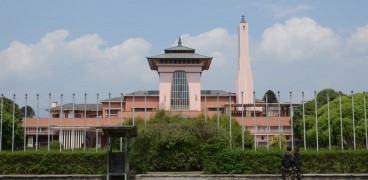Rolpa is a "hill" district in Nepal's Lumbini Province. Rolpa district has a population of 221,177 people living in an area of 1,879 km2 (725 sq mi). The administrative centre of the district is Rolpa town.
The region of Rolpa was ripe for revolution due to the population's many complaints. The Communist Party of Nepal designated it as a "Maoist Stronghold." A big fight between Maoist guerillas and the army took place along the Rolpa-Pyuthan border in May 2002 in Lisne Lekh.
History of Rolpa District
Before the 15th century, the Rolpa District was ruled by the Rukumkot (Rukum District) King. Tuthansen (King of Salyankot) formed a new kingdom from the Rukumkot Kingdom by cutting off 18 villages. Gajulkot was the name given to the new kingdom. Jayant Berma, the monarch of Rukumkot, gave these 18 villages to Tuthansen as a dowry. In Rolpa District, there is still ruins accessible.

Silence Tsho Rolpa
During the reign of Rana, the Rolpa district was divided into two districts: Pyuthan District and Salyan District. Rolpa district was created in 1962, carved out of portions of Pyuthan and Salyan districts.
How Can You Reach Rolpa District?
There are two ways by which you can reach the Rolpa district. They are:
- By Air
- By Road
By Air
The quickest way to go to Rolpa is via plane. Buddha Air flies from Kathmandu to Nepaljung International Airport. Rolpa is roughly a three-to-four-hour journey from Nepaljung. Rolpa is around 190 kilometres away from Nepaljung.
By Road
Rolpa is reached by regular bus from Gomgabu Bus Park through the east-west Mahendra Highway. It is 520 kilometres from Kathmandu, the capital city, and takes approximately 13-14 hours to get by bus.
When Is The Best Season To Visit Rolpa District?
The winter season is not ideal in Rolpa because it is located in the Himalayan area. Rolpa is best visited between October and December, and February and April.
Places to Visit in Rolpa District
Rolpa is a less-travelled and interesting place for adventurers. If you are in the Rolpa region and want to travel someplace, we have given some reasons below.
- Dhorpatan Hunting Reserve
- Guerilla Trek
- Jaljala
- Thawang
- Gadhilek
Dhorpatan Hunting Reserve
The Dhorpatan Hunting Reserve was created in 1987 and is Nepal's sole hunting reserve. It has a total size of 1,325 km2. Rukum, Myagdi, and Baglung are the three districts that make up this hunting reserve. This hunting reserve stretches from 2,850 meters to 5,500 meters in length. There are 58 vascular plants found here, as well as 18 animal species, 137 bird species, and two reptile species.
Guerilla Trek
Guerilla trekking was first launched in the year 2015. The Guerilla Trip, which begins in Beni and ends in Sulichaur in Rolpa, is a simple yet isolated trek. On your way to the guerrilla hike, you'll also pass through the Dorpatan Hunting Reserve. Guerilla treks are available for individuals interested in learning more about the Maoist cadres' way of living in difficult terrain.
You may also enjoy a magnificent panoramic view of the terrain, as well as unspoiled wildlife and native inhabitants. Jaljala Pass, Mt. Api, Saipal, Dhaulagiri, Annapurna, and numerous minor peaks are some of the stunning sights you'll see on the journey. Thakali, Chhetri, Brahmin, and Magar ethnic groups are some of Rolpa's most prevalent ethnic groupings.
Jaljala
With a height of 3,100 meters, Jaljala holds significant religious significance. Jaljala is well-known among Hindus because of the Lord Baraha shrine. Three times a year, devotees assemble here to worship god. The first is Baisakh's full moon day, followed by Jestha and Shrawan's full moon days.
Jaljala, at 3,100 meters above sea level, is a major religious site. The Lord Baraha temple at Jaljala is well-known among Hindus. Devotees gather here three times a year to worship god. Baisakh's full moon day is the first, followed by Jestha's and Shrawan's full moon days.
Jaljala is a day trek from Liwang that takes around 7-8 hours. You may witness a magnificent forest rich in animals such as Ghoral, Leopard, Himalayan bear, and Jackal while trekking. In the spring, devotees are also drawn to the rhododendron blooms.
Thawang
In Rolpa, Thawang is a lovely Magar hamlet. The Maoist insurrection is centred in this village. There are around 300 villages that provide a haven for Maoist leaders and fighters.
During the civil war, 33 residents of this community were killed. During the insurgency, 21 traditionally built wooden homes were also set on fire. However, this lovely community is presently lovely, tranquil, and has tourist possibilities.
Gadhilek
Standing on a mountaintop in the southern portion of Rolpa, Gadhilek is historically significant. The Chaubise kingdom constructed this vital fort. In Gadhilek, locals also built a view tower to add to the appeal.
It is also stated that Swargadwari Mahaprabhu, Swargadwari of Pyuthan, was born here. A panoramic view of the Annapurna range, Sisne Himal, and a lovely valley can be seen.







